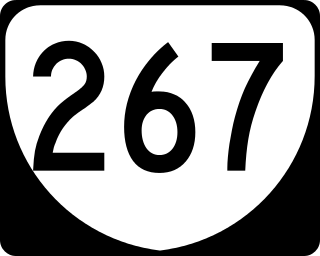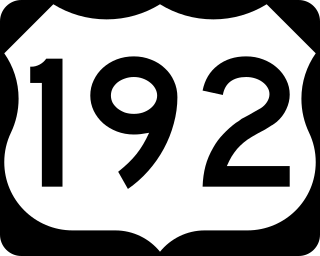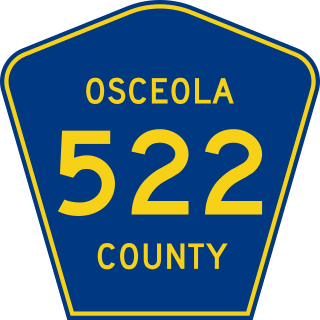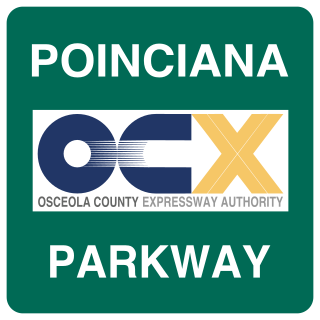
The Reedy Creek Improvement District (RCID) is the governing jurisdiction and special taxing district for the land of Walt Disney World Resort. It includes 39.06 sq mi (101.2 km2) within the outer limits of Orange and Osceola counties in Florida. It acts with the same authority and responsibility as a county government. It includes the cities of Bay Lake and Lake Buena Vista, and unincorporated RCID land.

The New Jersey Turnpike (NJTP) is a system of controlled-access highways in the U.S. state of New Jersey. The turnpike is maintained by the New Jersey Turnpike Authority (NJTA). The 117.20-mile (188.62 km) mainline's southern terminus is at a complex interchange with Interstate 295 (I-295), U.S. Route 40 (US 40), US 130, and Route 49 near the border of Pennsville and Carneys Point townships in Salem County, one mile (1.6 km) east of the Delaware Memorial Bridge. Its original northern terminus was at an interchange with I-80 and US 46 in Ridgefield Park, Bergen County; the turnpike was later extended to the George Washington Bridge and New York City. Construction of the mainline from concept to completion took 23 months, from 1950 to 1952. It was officially opened to traffic on November 5, 1951, between its southern terminus and exit 10.

A toll road, also known as a turnpike or tollway, is a public or private road for which a fee is assessed for passage. It is a form of road pricing typically implemented to help recoup the costs of road construction and maintenance.

Bay Lake is a city in Orange County, Florida, United States. The population was 29 at the 2020 census. It is named after a lake that lies east of the Magic Kingdom. All four of the Walt Disney World Resort theme parks, and one of Walt Disney World's two water parks, are in Bay Lake, though all Disney parks in the region have mailing addresses in nearby Lake Buena Vista.

The Garden State Parkway (GSP) is a controlled-access toll road that stretches the north–south length of eastern New Jersey from the state's southernmost tip near Cape May to the New York state line at Montvale. Its name refers to New Jersey's nickname, the "Garden State". The parkway is designated by the New Jersey Department of Transportation (NJDOT) as Route 444, although this designation is unsigned. At its north end, the road becomes the Garden State Parkway Connector, a component of the New York State Thruway system that connects to the Thruway mainline in Ramapo. The parkway is the longest highway in the state at approximately 172 miles (277 km), and, according to the International Bridge, Tunnel and Turnpike Association, was the busiest toll road in the United States in 2006. Most of the highway north of the Raritan River runs through heavily populated areas. Between the Raritan River and the township of Toms River, the highway passes through lighter suburban development, while south of Toms River, the road mostly runs through unspoiled wilderness in the Pine Barrens and swampland. The highway has a posted speed limit of 65 miles per hour (105 km/h) for most of its length and is primarily for passenger vehicle use; trucks weighing over 10,000 pounds (4,500 kg) are prohibited north of exit 105.

State Route 267 is a primary state highway in the US state of Virginia. It consists of two end-to-end toll roads – the Dulles Toll Road and Dulles Greenway – as well as the non-tolled Dulles Access Road, which lies in the median of Dulles Toll Road and then extends east to Falls Church. The combined roadway provides a toll road for commuting and a free road for access to Washington Dulles International Airport. The three sections are operated and maintained by separate agencies: Dulles Toll Road and Dulles Access Road are maintained by the Metropolitan Washington Airports Authority (MWAA); the Dulles Greenway is owned by TRIP II, a limited partnership, but is maintained by Atlas Arteria, an Australian company which owns the majority stake in the partnership. The Dulles Access Road's median hosts the Silver Line of the Washington Metro between Reston and Falls Church.
E‑ZPass is an electronic toll collection system used on toll roads, toll bridges and toll tunnels in the Eastern United States, Midwestern United States, and Southern United States. The E-ZPass Interagency Group (IAG) consists of member agencies in several states, which use the same technology and allow travelers to use the same transponder on toll roads throughout the network. Since its creation in 1987, various independent systems that use the same technology have been folded into the E-ZPass system, including the I-PASS in Illinois and the NC Quick Pass in North Carolina. Negotiations are ongoing for nationwide interoperability in the United States.
Florida's Turnpike, designated as unsigned State Road 91, is a toll road in the U.S. state of Florida, maintained by Florida's Turnpike Enterprise (FTE). Spanning approximately 309 miles (497 km) along a northwest–southeast axis, the turnpike is in two sections. The SR 91 mainline runs roughly 265 miles (426 km), from its southern terminus at an interchange with Interstate 95 (I-95) in Miami Gardens to an interchange with I-75 in Wildwood at its northern terminus. The Homestead Extension of Florida's Turnpike continues from the southern end of the mainline for another 48 miles (77 km) to US Highway 1 in Florida City. The slogan for the road is "The Less Stressway". The mainline opened in stages between 1957 and 1964, while the extension was completed in 1974. The turnpike runs through Miami, Fort Lauderdale, and West Palm Beach, where it parallels I-95, and through Orlando, where it crosses I-4.
State Road 417 (SR 417), also known as the Central Florida GreeneWay, Seminole County Expressway, Eastern Beltway and Orlando East Bypass, is a tolled limited-access state highway forming the eastern beltway around the city of Orlando, Florida, United States. It is owned and maintained by the Central Florida Expressway Authority (CFX) and Florida's Turnpike Enterprise. The CFX section was posthumously named after former Orlando Orange County Expressway Authority chairman Jim Greene.

The Capital Beltway is a 64-mile (103 km) Interstate Highway in the Washington metropolitan area that surrounds Washington, D.C., the capital of the United States, and its inner suburbs in adjacent Maryland and Virginia. It is the basis of the phrase "inside the Beltway", used when referring to issues dealing with U.S. federal government and politics. The highway is signed as Interstate 495 (I-495) for its entire length, and its southern and eastern half runs concurrently with I-95.

U.S. Route 192 is an east–west route of the United States Numbered Highway system in central Florida. It runs 75.04 miles (120.77 km) from U.S. Route 27 in Four Corners, Lake County, east past Walt Disney World and through Kissimmee, St. Cloud and Melbourne, to end at State Road A1A in Indialantic, one block from the Atlantic Ocean. It crosses its "parent", U.S. Route 92, in Kissimmee, for only 3700 feet.
State Road 429 (SR 429), also known as the Daniel Webster Western Beltway or Western Expressway south of US 441, and the Wekiva Parkway north of US 441, is a limited-access toll road built and maintained by the Central Florida Expressway Authority (CFX), the Florida's Turnpike Enterprise, and the Florida Department of Transportation (FDOT). Its mainline currently extends 51.77 miles (83.32 km) from I-4 (SR 400) in Four Corners north to SR 46 in Seminole County, west of Sanford. Control cities are Apopka and Tampa although the control cities for traffic at the entrances at US 441 and north are Orlando, Tampa, and Daytona Beach. SR 429 was originally planned as a western half of SR 417.
State Road 589 (SR 589), also known as the Veterans Expressway and Suncoast Parkway, is a north–south toll road near the Florida Gulf Coast. Maintained and operated by Florida's Turnpike Enterprise, this 68-mile (109 km) transportation corridor extends from State Road 60 in Tampa, north to State Road 44 near Lecanto. The Veterans Expressway was built to accommodate the increasing commuter traffic in the Tampa-St. Petersburg metropolitan area, with the Suncoast Parkway opening in 2001, extending from near the northern terminus of the Veterans Expressway to U.S. Route 98, with a possible northern extension to U.S. Route 19/U.S. Route 98 in Crystal River in Citrus County in the planning and development stages. As of February 28, 2022, Phase I of the extension is now open between US 98 and Florida State Road 44. Phase II, which would further extend the highway to County Road 486, is undergoing the design phase.

Osceola Parkway, signed as County Road 522 (CR 522) since around 2003, is a 17.5-mile-long (28.2 km), partially tolled arterial road extending east–west across the northern boundary of Osceola County, Florida, roughly paralleling the border with Orange County. It connects Walt Disney World with Interstate 4 and Florida's Turnpike before terminating at Simpson Road near Buenaventura Lakes, and is maintained by Osceola County. Only the section between the Southern Connector and a toll plaza east of Shingle Creek is tolled; the rest includes mainly at-grade intersections. A portion of the Osceola Parkway was once called Dart Boulevard.
State Road 570 (SR 570), also known as the Polk Parkway, is a 24-mile (39 km), limited-access toll road which runs through Polk County, Florida. It is operated as part of Florida's Turnpike Enterprise system of limited-access expressways. The Polk Parkway mainly serves as a beltway around Lakeland forming a semicircle, which along with I-4 circumscribes most of the city limits of Lakeland.

Open road tolling (ORT), also called all-electronic tolling, cashless tolling, or free-flow tolling, is the collection of tolls on toll roads without the use of toll booths. An electronic toll collection system is usually used instead. The major advantage to ORT is that users are able to drive through the toll plaza at highway speeds without having to slow down to pay the toll. In some installations, ORT may also reduce congestion at the plazas by allowing more vehicles per hour/per lane.
There are approximately 25 current toll roads in the state of Texas. Toll roads are more common in Texas than in many other U.S. states, since the relatively low revenues from the state's gasoline tax limits highway planners' means to fund the construction and operation of highways.

State Road 538 (SR 538), also known as the Poinciana Parkway, is a 7.22-mile-long (11.62 km) toll road built in Osceola and Polk Counties, Florida. Construction began in 2013 and was completed in 2016. The road had been planned for decades to provide a traffic outlet from Poinciana northwest to US 17/US 92 and Interstate 4. Costs skyrocketed after land along the planned route was converted to a mitigation bank, requiring a bridge to span most of the 1.2 miles (1.9 km) stretch through the restored wetland. The road was originally planned to be built by Avatar—the primary developer of Poinciana—as a four-lane, limited-access highway; after the decision was made to build the bridge across the mitigation bank a toll was planned for the bridge segment of the road, but the collapse of the 2000s housing bubble and increased costs forced Avatar to abandon their plans to build the private toll road. About the same time, Osceola County formed the Osceola County Expressway Authority to build a loop road around the Kissimmee-St.Cloud area, which would include the Poinciana Parkway.
Foley Beach Express (FBE) is a 14.0-mile-long (22.5 km) limited-access four-lane partial toll road near the beaches of Baldwin County near the Gulf of Mexico in the southwestern part of the U.S. state of Alabama. It serves as an alternate route for the heavily traveled State Route 59 (SR 59) in nearby Gulf Shores. The southern terminus of the highway is at an intersection with SR 180 in the northwestern part of Orange Beach. The northern terminus of the highway is at an intersection with SR 59 in the far north part of Foley. The extreme southern portion of the highway is part of Alabama's Coastal Connection, a National Scenic Byway.












